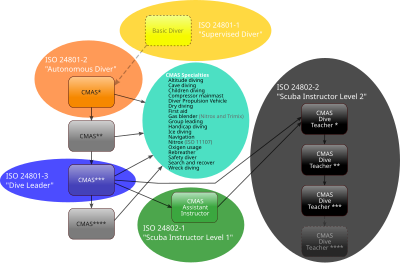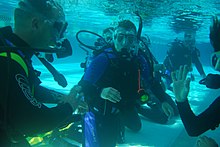Diving training
A diver education is the learning and training of diving skills. In addition, a student diver learns the use and handling of the necessary equipment.
As with many sports, diving has special risks and dangers. The training should enable an assessment and the safe handling of these risks. During the training, the student divers are introduced to diving practice step by step and in coping with unexpected problems such as B. trained a venting regulator . With a successfully completed diving training, a student receives a certification . Diving centers and clubs often check the level of training and the practice acquired using these diving certificates and the logbook before a person is taken on diving excursions and diving sites.
Training


The content and the course of a training course is basically determined by the specifications of a diving organization . The diving instructor can take a diving course within certain limits on z. B. adapt local conditions. The aim is to impart the theoretical and practical knowledge that a diver needs to be able to dive safely. The training courses of most diving organizations today conform to the ISO 24801-1 to 24801-3 standard and are therefore compatible with one another with minor restrictions.
A diving course can be a group or individual course over several days, weeks, as a weekend or compact course, e.g. B. be completed on vacation. Combinations are often possible.
Student divers
Often there is an introductory dive before the actual diving training , which offers interested non-divers the opportunity to test the diving sport practically without having to complete an entire diving course.
With a minimum of physical fitness and swimming skills, anyone can take part in a diving course where a medical examination confirmed the health requirements for diving. Many diving organizations require a minimum age for participation in courses and offer special children's and junior programs with appropriate certifications. Even physically handicapped people have the opportunity to scuba diving in the special offers for the Handicapped Diving to learn. In addition, offers for mentally disabled people and educational approaches for children and young people with behavioral problems were developed.
theory and practice
Diving training provides the necessary theoretical knowledge and practical skills. All diving organizations have a modular structure. For example, the PADI Open Water Diver (OWD) focuses on the diver himself and the use of his own equipment. The Advanced Open Water Diver (AOWD) focuses on the diving environment and the Rescue Diver (RD) on safety aspects and emergency management as well as cardiopulmonary resuscitation . The Divemaster (DM), in turn, focuses on group leadership and assisting with diving training. Specialty courses focus on just one specific topic.
Basic diving training (e.g. OWD or one-star) is usually divided into three parts.
- Conveyance and testing of theoretical knowledge in self-study , frontal teaching or e-learning .
- Demonstration and practice of diving skills in a swimming pool or in confined water, d. H. in a manageable and safe environment.
- Exercise and practical test in open water.
In the case of training for advanced divers (e.g. AOWD, two-star or special courses), there are usually no pool lessons.
- Theoretical training
- The diving theory training usually includes the subjects of physics , medicine , decompression theory , dive planning , diving signs , navigation , pneumatics , marine biology , first aid , emergency management , monument and environmental protection .
- Practical training
- In diving practice, water and diving skills are taught: assembling the equipment, getting into the water, diving up and down, swimming with fins , snorkeling , breathing from a regulator , using diving signs, buddy system , buoyancy using the buoyancy compensator and lungs , air management , Alternating breathing , practical emergency management, underwater navigation, equipment maintenance, first aid, underwater rescue, correct use of signal buoys and diving flags .
Additional diving skills are covered in special courses such as B. use of a lift bag , searching under the water, night dives , dry diving , apnea diving , Cavediving , Wreckdiving , altitude diving , ice diving , Children diving , group management , Solo diving , nitrox , oxygen -Nothilfe, underwater photography , underwater archeology or marine biology .
For technical divers there are training opportunities in the field of rebreathers , special breathing gas mixtures such as Trimix or Heliox , deep penetration into caves (full cave diving), handling additional cylinders ( stages ), full face masks or helmet diving equipment .
Dive guide
After learning and deepening the basic knowledge, a diver can complete the training to become a group leader. He is entitled to as a dive guide or dive guide (or dive leader ; German: dive guide . Resp diving guide ; the English term Guide . Has prevailed in the German-speaking) more trained divers for a dive to briefen and bring them under water.
The ISO 24801-3 standard standardizes the so-called dive leader training. Most diving organizations offer compatible diving guide training. Most of the time, however, they also award organization-specific and additional guide certifications. The PADI Divemaster , CMAS *** , IDEA Divemaster or SSI Dive Guide correspond to the ISO standardized Dive Leader training. In addition to group leadership, the training includes complete diving-specific theory such as B. Physics , Medicine , Equipment , Diving Procedures, Dive Planning , Environment, Conditional Skills , Diving Skills, Risk Management, Diver Safety and Marketing. With the offered crossover procedures, certified guides can also become diving guides from other organizations.
While diving schools and diving centers sometimes employ full-time guides, the majority of the diving guides in associations work on a voluntary basis and part-time. Because of the great competition in the tourism industry and the diving organizations that train too many dive guides, the earning potential for dive guides worldwide is rather low. In addition, they often see themselves in direct competition with better trained diving instructors when applying for a job. In many places, therefore, only diving instructors are employed for the task of diving guides.
Diving instructor
The instructor (English: Instructor ) forms the immersion students in theory and practice, and verifies that they can dive safely enough to be certified at. Often he also leads, as a diving guide, dives with trained divers or takes responsibility for diving trips.
Many diving organizations offer training to become a diving instructor at various levels. The ISO 24802-1 and 24802-2 standards standardize two so-called scuba instructor levels . Most diving organizations offer compatible diving instructor training courses. Most of the time, they also award organization-specific and much more extensive diving instructor certifications. The training includes the training standards and objectives of the organization, the complete diving-specific theory such as B. Physics , medicine , equipment , diving procedures, the environment, conditional skills, the diving skills at demonstration level, teaching operations, conveying content in the courses, logistical skills, risk management, the safety of diving students and marketing. A training concludes with z. Sometimes several days of written and practical exams.
With the offered crossover procedures, certified instructors can also become diving instructors of another organization. Diving instructors usually have to complete a shortened training course in order to be recognized as diving instructors by another diving organization in the crossover procedure. During such a crossover course, you will be familiarized with the peculiarities and philosophy of the respective diving organizations.
While diving schools and diving centers mostly employ full-time diving instructors, the majority of the diving instructors in associations work on a voluntary basis and part-time. Because of the great competition in the tourism industry and the diving organizations that train and certify too many diving instructors, the earning potential for diving instructors worldwide is rather low. Only as the owner of a base or school can a diving instructor earn better.
Diving organizations
The best-known diving organizations that set regulations for diving courses and certify divers are:
- Confédération Mondiale des Activités Subaquatiques (CMAS), Diving Instructor World Association (DIWA), National Association of Underwater Instructors (NAUI), Professional Association of Diving Instructors (PADI), Scuba Schools International (SSI), Verband Deutscher Sporttaucher (VDST)
- DIWA, Global Underwater Explorers (GUE), IAC Tec , NAUI Tec, PADI TecRec, SSI, Technical Diving International (TDI), American Nitrox Divers International (ANDI)
Internationally, most divers are trained according to PADI and SSI. In Germany, the majority of non-commercial diving clubs train according to the CMAS guidelines. The two largest non-commercial training organizations in Germany are the VDST and the Deutsche Lebens-Rettungs-Gesellschaft (DLRG), which are members of CMAS Germany .
The training companies for professional diving and the military train professional divers and weapon divers according to their own specifications and according to their specific needs .
Legal
Before training in recreational diving, the student is required to undergo a diving suitability test , with which the health requirements for diving are proven. This diving medical examination should be repeated every two years and annually from the age of 40.
Diving courses for recreational divers are offered by various diving organizations. Today most of these diving organizations are certified to the international standards ISO 24801, ISO 24802 and ISO 11107. Many diving organizations therefore mutually recognize their training levels and allow a diver to continue training according to their regulations on the basis of a foreign certification. In such a crossover , an additional proof of performance is sometimes required.
Training for professional divers is regulated by law in Germany and there are separate regulations for special areas of application.
Web links
Individual evidence
- ↑ Recreational diving services - Requirements for the training of recreational scuba divers - Part 1: Level 1 - Supervised diver (ISO 24801-1). ISO , accessed April 29, 2015 .
- ↑ Recreational diving services - Requirements for the training of recreational scuba divers - Part 2: Level 2 - Autonomous diver (ISO 24801-2). ISO, accessed April 29, 2015 .
- ↑ a b Recreational diving services - Requirements for the training of recreational scuba divers - Part 3: Level 3 - Dive leader (ISO 24801-3). ISO, accessed April 29, 2015 .
- ↑ Recreational diving services - Requirements for the training of scuba instructors - Part 1: Level 1 (ISO 24802-1). ISO , accessed April 29, 2015 .
- ↑ Recreational diving services - Requirements for the training of scuba instructors - Part 2: Level 2 (ISO 24802-2). ISO , accessed April 29, 2015 .
- ↑ a b CMAS.CH Crossover Days. (PDF) Pilotkirs. (No longer available online.) CMAS.CH, August 8, 2012, archived from the original on July 14, 2014 ; Retrieved July 11, 2014 . Info: The archive link was inserted automatically and has not yet been checked. Please check the original and archive link according to the instructions and then remove this notice.
- ↑ a b SSI Crossover Program. SSI , accessed July 11, 2014 .
- ↑ Marcel Kaspar: Income as a diving instructor - Can I get rich in paradise? swissnomads.ch, October 15, 2013, accessed on May 12, 2014 .
- ↑ Georg Wolf: Diving Instructor: Dream Job or Nightmare? (No longer available online.) Diving (magazine) , year Top Special Verlag GmbH & Co. KG, archived from the original on June 22, 2013 ; Retrieved January 21, 2013 . Info: The archive link was inserted automatically and has not yet been checked. Please check the original and archive link according to the instructions and then remove this notice.
- ↑ Recreational diving services - Requirements for the training of recreational scuba divers - Part 1: Level 1 - Supervised diver (ISO 24801-1). ISO , accessed April 29, 2015 .
- ↑ Recreational diving services - Requirements for the training of scuba instructors - Part 1: Level 1 (ISO 24802-1). ISO , accessed April 29, 2015 .
- ↑ Recreational diving services - Requirements for introductory training programs to scuba diving (ISO 11121). ISO , accessed April 29, 2015 .



